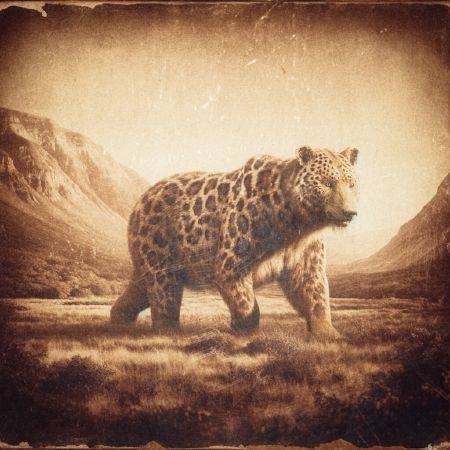Leopard Mountains: Difference between revisions
No edit summary |
No edit summary |
||
| (3 intermediate revisions by the same user not shown) | |||
| Line 1: | Line 1: | ||
Situated at the far western edge of [[Oldeshire]], just south of the former Oranjestad colony of [[Garbanzo]], '''The Leopard Mountains''' stand as a remarkable mountain range, with its highest peak, Ravenmoore, located directly south of the town sharing its name. Primarily inhabited by nomadic tribes, this region hosts a distinctive ecosystem that's home to several unique and endangered species, some of which have sadly gone extinct, including the Ballzahkary macaque, the now-extinct Leopard bear (Oldeshire's only native bear), the Ballzahkary stag, and the Leopard Mountain badger. | |||
The | [[File:leopardbear.jpg|450px|thumb|center|The last image of the Leopard Bear, taken in 1889 near present-day Stonegate]] | ||
==Geology== | ====Geology==== | ||
The | The foundation of most of western Oldeshire's basement rock predates the Leopard Mountains and was formed during the Precambrian period. The Leopards themselves were shaped through three successive phases of Earth's geological evolution. | ||
The initial tectonic deformation phase primarily involves the "Anti"-Leopard Mountains, created about 300 million years ago in the Paleozoic Era due to continental collisions. These mountains were believed to be part of the Aarghorian orogeny, formed when Oldeshire and Oblitus tectonic plates collided, once rivalling the modern Athitican range. | |||
The second phase, during the Mesozoic Era before approximately 66 million years ago, saw the widespread extension and separation of the Earth's crust, giving rise to the present Leopard Mountains. The majority of the rocks comprising the surface were deposited in an ocean during that time. | |||
Finally, in the Paleogene and Neogene Periods, approximately 66 million to 1.8 million years ago, the Leopard chains experienced uplift due to magmatic pressure. | |||
The | ====Natural resources==== | ||
The Leopard Mountains boast a wealth of natural resources, including iron ore, lead ore, copper, silver, mercury, rock salt, phosphate, marble, anthracite coal, and natural gas, among others. | |||
====Legal Status==== | |||
In 1931, explorers from [[Oranjestad]] charted and documented the mountains, then relatively unexplored outside of the local tribes. These explorations resulted in a claim on the mountains for the nation. However, no permanent settlement was attempted, leaving the legal claim to the mountain range in dispute. | |||
In 1946, the S.U.N. convened to settle the dispute, declaring the Leopard Mountains as open and freely accessible to all nations, with Oranjestad appointed as the Caretaker and Warden of this expansive and significant natural region. | |||
== | |||
== | |||
In 1931, explorers from Oranjestad | |||
In 1946, | |||
Latest revision as of 20:28, 20 December 2023
Situated at the far western edge of Oldeshire, just south of the former Oranjestad colony of Garbanzo, The Leopard Mountains stand as a remarkable mountain range, with its highest peak, Ravenmoore, located directly south of the town sharing its name. Primarily inhabited by nomadic tribes, this region hosts a distinctive ecosystem that's home to several unique and endangered species, some of which have sadly gone extinct, including the Ballzahkary macaque, the now-extinct Leopard bear (Oldeshire's only native bear), the Ballzahkary stag, and the Leopard Mountain badger.

Geology
The foundation of most of western Oldeshire's basement rock predates the Leopard Mountains and was formed during the Precambrian period. The Leopards themselves were shaped through three successive phases of Earth's geological evolution. The initial tectonic deformation phase primarily involves the "Anti"-Leopard Mountains, created about 300 million years ago in the Paleozoic Era due to continental collisions. These mountains were believed to be part of the Aarghorian orogeny, formed when Oldeshire and Oblitus tectonic plates collided, once rivalling the modern Athitican range. The second phase, during the Mesozoic Era before approximately 66 million years ago, saw the widespread extension and separation of the Earth's crust, giving rise to the present Leopard Mountains. The majority of the rocks comprising the surface were deposited in an ocean during that time. Finally, in the Paleogene and Neogene Periods, approximately 66 million to 1.8 million years ago, the Leopard chains experienced uplift due to magmatic pressure.
Natural resources
The Leopard Mountains boast a wealth of natural resources, including iron ore, lead ore, copper, silver, mercury, rock salt, phosphate, marble, anthracite coal, and natural gas, among others.
Legal Status
In 1931, explorers from Oranjestad charted and documented the mountains, then relatively unexplored outside of the local tribes. These explorations resulted in a claim on the mountains for the nation. However, no permanent settlement was attempted, leaving the legal claim to the mountain range in dispute. In 1946, the S.U.N. convened to settle the dispute, declaring the Leopard Mountains as open and freely accessible to all nations, with Oranjestad appointed as the Caretaker and Warden of this expansive and significant natural region.